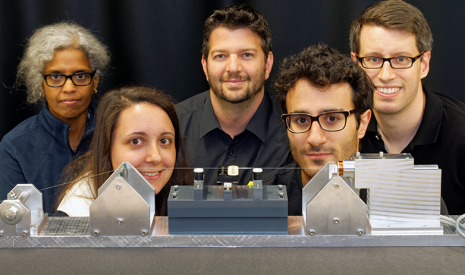Measuring forces with oscillations

Researchers at ETH Zurich have discovered a peculiar feature in oscillations similar to that of a child's swing. As a result, they have succeeded in outlining a novel principle for small, high-resolution sensors, and have submitted a patent application for it.
A child swings on a swing, gaining momentum with its legs. For physicists, this is a reasonably easy movement. They call it parametric oscillation. Things are getting more complicated if - in addition to the child's efforts - the mother (or the father) is around to push the swing. The interaction between the pushing force and the parametric oscillation can become very intricate, making it hard to calculate how much force the parent expends from the resulting irregular swinging motion.
An interdisciplinary team of theoretical and experimental physicists at ETH Zurich has now succeeded in this very calculation. The researchers have been able to describe for the first time how parametric oscillation (the child's own drive) can be used to measure an external force (the parent's push). Their discovery has applications for sensors, and the scientists have submitted a patent application for the underlying principle.
Advantages for small sensors
"Many of today's sensors are already based on oscillations," says Oded Zilberberg, a professor at the Institute for Theoretical Physics. "With small resonators you can measure, for example, force, pressure, mass, sound or temperature. Atomic force microscopes are also built on this principle." But these applications - often found in the field of microtechnology - currently use less intricate oscillations known as harmonic oscillations.
For these measurements to use intricate oscillations, as Zilberberg and his colleagues propose, a paradigm shift is necessary: sensors would have to be designed differently. The new principle brings particular advantages for very small sensors, says the physicist. It would make it possible to build extremely small yet precise sensors, as the measuring signal in the new principle stands out better against background noise than with current methods.
Experiments with atoms and guitar strings
The scientists discovered the new principle while analysing parametric oscillations in a quantum physics experiment with laser-trapped rubidium atoms. Having understood the fundamental interaction between parametric and pushed oscillations, the researchers then directly demonstrated the effect using a parametrically oscillating guitar string. The scientists exerted a pulsating force on the string while continuously varying the frequency of the pulse. The researchers observed that the strength of the vibration of the string (amplitude) did not change fully continuous, but there was rather a sharp jump in amplitude at a particular frequency. As they discovered, this 'jump frequency' depends directly on the strength of the applied force and can therefore be used as a force meter.
Zilberberg and his colleagues are now looking for industrial partners to help develop high-resolution sensors. The new principle could even be applied in computer technology. Zilberberg: "In the very early stages of the computer age there were computer memories that were based on oscillators, known as parametrons. The computer industry later lost interest in them, but our discovery could breathe new life into this field of research."
More information: Luca Papariello et al, Ultrasensitive hysteretic force sensing with parametric nonlinear oscillators, Physical Review E (2016). DOI: 10.1103/PhysRevE.94.022201
R. Chitra et al. Dynamical many-body phases of the parametrically driven, dissipative Dicke model, Physical Review A (2015). DOI: 10.1103/PhysRevA.92.023815
Journal information: Physical Review E , Physical Review A
Provided by ETH Zurich




















